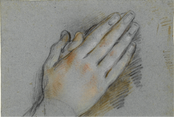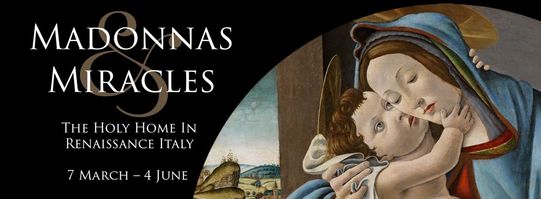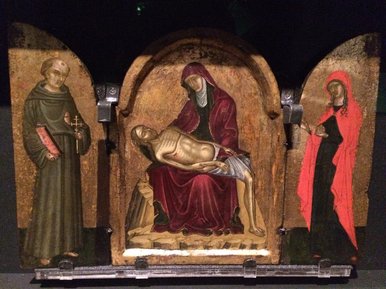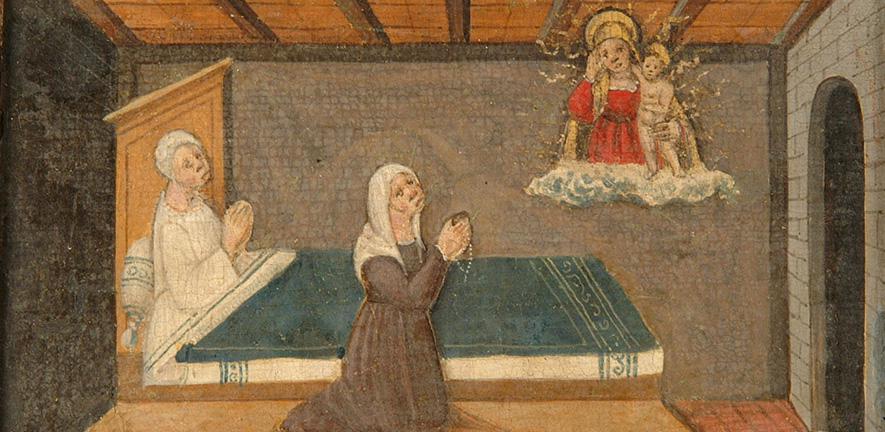Anne Maria Clarke @ the Fitzwilliam Museum Cambridge

What we see in the Renaissance are the last days so to speak of this incredibly ancient tradition. The rise of Secularism within the Renaissance period, the Protestant Reformation then Counter Reformation in Italy would all curb its practice significantly and dampen what was deemed its most florid excesses and yet still - though much tempered – the remnants these practices have persisted through to this day in Catholic homes across the world - one has only to look at the paraphernalia on sale in church book shops to see it has not gone away. It thrives too, uninterrupted in other traditions, in Hinduism, Buddhism, Taoism and so on. Every home where such faiths are practised has its own alter decorated with flowers, prayer beads, incense and candles in much the same way, although with different iconography as home alters would have been decorated in Renaissance Italy. And yet to northern, more sober Protestant or secular born souls - such expressions of devotion can seem rather remote, archaic even. The exhibition therefore is an opportunity to revisit a time when such practices flourished and to see some of the objects and works of art from that period.
From birth to death, from waking to retiring and everything in-between, daily life in the Renaissance home would have been interspersed with prayer and devotion. Holy water, flickering candle-light, whispered verses read by those who were able from treasured hand-made books passed down the generations of La famiglia - sacred songs and graces intoned before every meal would have all created ambiances conducive to devotion.
Beginning with childbirth the exhibition features several precious heirloom paintings of the Birth of the Virgin, a popular theme of the times depicting Saint Ann, the Virgin's mother – a mature woman thought to have been too old to have become pregnant – resting in her bed after successfully giving birth attended by several young women whilst the anxious menfolk wait outside the room.
There is a beautiful blue and white ceramic Nativity on show used to both celebrate and to tell the story of Christ's own birth. Young children we are told, would have been taught in such ways through storytelling and imaginative play before progressing to more serious and probably less delightful forms of instruction.
And yet those taught to read together with those who were not would have no doubt all been enchanted by the precious illuminated manuscripts and popular Books of Hours that some families possessed. These exquisite volumes, of which the exhibition features several were primarily created for women and often given to brides as wedding presents by their husbands. Not everyone could afford them of course and they varied considerably with more wealthy families being able to commission the most lavish illuminations sometimes featuring their loved ones in acts of prayer and devotion - yet even the most modest volumes owned by the evolving merchant classes were beautifully inscribed and most elaborately decorated and painted with rare pigments like the highly prized ultramarine created from lapis lazuli and expensive gold leaf designed to gleam on the page creating a palpable luminosity greatly accentuated when viewed in candle light. These were the kinds of books whose lavish pages were designed to draw the observer in and in – like mandalas in a way – each page a meditation and a mystery to be poured over for hours at a time and returned to repeatedly over the course of a life-time.
The exhibition features a beautifully bound miniature volume from Rome dated 1585 called Giordinetto – Little Garden of Spiritual things which includes prayers for different times of the day, psalms and sonnets to be learned and recited. There is a lovely book dated 1478 entitled Vitae Christi le Devote Meditazioni Sopra la Passione del Nostro Signore – Devotional Meditations upon the Passion of our Saviour - once owned by two nuns and complete with their neat margin notes – testament, the exhibition notes point out as to how carefully and thoroughly it had been read.
The Sacred Music that was part of daily life is represented too and to give a flavour of what might have been heard five short pieces were recorded at St Katharine's College Cambridge by an early music vocal ensemble The Clerks including a beautiful lauda venerating the Virgin and a meditation on the Passion which can be heard on head phones provided.
Various bodily adornments are on display too - amulets and rings inscribed with the sacred symbol of the Angus Die ( Lamb of God). There are pendants and crucifixes, blessed and worn close to the heart and rosary beads (introduced in the 15th century) created with precious and semi-precious stones. Nothing it seems was left outside the sphere of the sacred.
Particularly lovely are some of the minature triptychs on display. These are alter pieces composed of three panels depicting a series of related religious images. During the day when not in use the outer wings would have been closed and indeed it was quite normal for all religious paintings to have been turned from away from view when not in use. Whilst travelling, we are told it would have been quite common to take these objects along and to open them for prayer as required.
As well as the collections of domestic iconography the exhibition also featuresa rare Fra Angelico painting entitled The Dead Christ and the famous Botticelli, Madonna and Child - a prize possession of the Fitzwilliam and the image chosen as the exhibitions poster.
The exhibitions title Madonnas & Miracles benefits hugely from the clarification of the sub-heading which more specifically describes its content - this being said - the Madonna was the undoubted the focus of much domestic devotion and it was to her it seems that the penitent most often appealed during childbirth, illness and death, times when women have historically been in close attendance.
Ave Maria, gratia plena, Dominus tecum, benedicta tu in mulieribus, et benedictus fructus ventris tui, Jesus. Sancta Maria, Mater Dei, ora pro nobis peccatoribus, nunc et in hora mortis nostrae. Amen.
Hail Mary, full of grace, the Lord is with thee, blessed art thou amongst women & blessed is the fruit of thy womb, Jesus. Holy Mary, mother of God, pray for us sinners now & at the hour of our death.
As for the exhibitions theme of miracles, there are numerous panel paintings called ex-votos which would have been left at local shrines giving thanks for wondrous healings from all manner of diseases and miraculous survivals during fires and natural disasters like earthquakes, still to this day an ever-present danger in regions like La Marche. There is an antique baby Christ Child doll, pulled intact from the rubble of the 5.5 earthquake which entirely destroyed the ancient Franciscan nunnery of the Poor Clares of Santa Chiara in Camerino just last year- leaving only this iconic figure untouched by the devastation. Interestingly this doll – and not just because of the earthquake – is venerated on the Feast of the Epiphany by local folk who annually queue to kiss its feet – in just the same way no doubt as previous generations have done since its creation at the height of the Renaissance.
Many attending this exhibition will have been brought up in a world where even if they went to church, their walls would have long since been white-washed and their colourful iconography obliterated, destroyed or confiscated. Images of the Madonna in particular have long since disappeared along with beloved saints to whom the people prayed in church and in their homes. Such practices had no place in the new more rationally inclined world of the post – Reformation period.
And yet as we have seen such practices persist and not just within Catholicism. There is something primal about alter making - about making sacred space - even if it is merely lighting a tea light and placing it next to a pot of wild flowers or leaving a bouquet on the roadside where someone has tragically died. Those performing such acts may no longer regard themselves as religious – but are still drawn towards this kind of expression – profound gestures indeed - and pointers maybe toward what spiritual practice in a post – patriarchal, post- religious future might look like. For there seems no doubt that even in such a scenario where the church as we know it today is no more - the spiritual nature of human kind will endure.
The Fitzwilliam Museum has created a stunning exhibition – a veritable time-capsule if you like capable of transporting the willing participant to the very heart of the Italian Renaissance home - and in so doing it has inspired contemplation upon the notion of what it might be within the human soul that is drawn to express itself in such ways - is it simply to garner favour in the next world so to speak - or is there something more profound being responded to within the psyche - and that in creating sacred space, our ancestors sought as maybe we still seek - in our own unique ways - to remember, to honour and to connect with the divine root of our being in the midst of earthly life.
much love
Anne Maria Clarke
x x x
http://www.youtube.com/c/annemariaclarke
More fairy-stories, myths & legends by
Anne Maria Clarke
http://www.archivepublishing.com
www.annemariaclarke.net
www.annemariaclarke.net/blog




